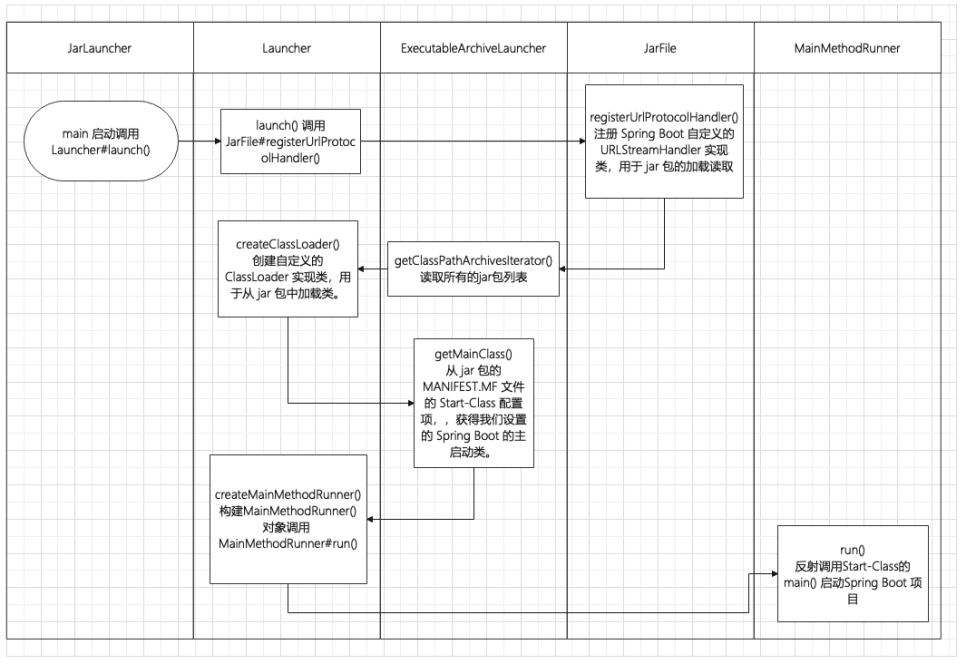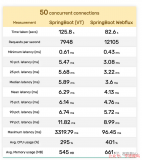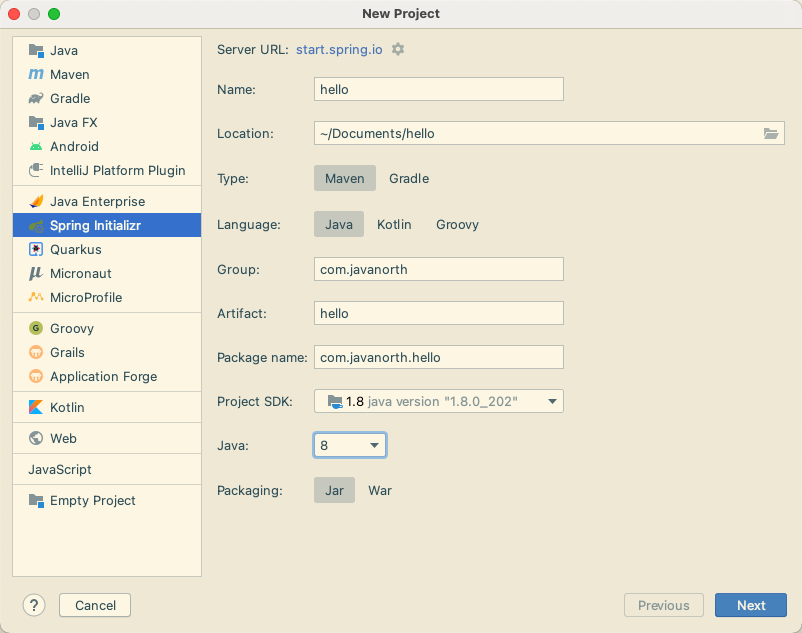首先,先看SpringBoot的主配置类:
@SpringBootApplicationpublic class StartEurekaApplication
{
public static void main(String[] args)
{
SpringApplication.run(StartEurekaApplication.class, args);
}
}
点进@SpringBootApplication来看,发现@SpringBootApplication是一个组合注解。
@Target(ElementType.TYPE)
@Retention(RetentionPolicy.RUNTIME)
@Documented@Inherited@SpringBootConfiguration@EnableAutoConfiguration@ComponentScan(excludeFilters = {
@Filter(type = FilterType.CUSTOM, classes = TypeExcludeFilter.class),
@Filter(type = FilterType.CUSTOM, classes = AutoConfigurationExcludeFilter.class) })
public @interface SpringBootApplication {
}
首先我们先来看 @SpringBootConfiguration:
@Target({ElementType.TYPE})
@Retention(RetentionPolicy.RUNTIME)
@Documented@Configurationpublic @interface SpringBootConfiguration {
}
可以看到这个注解除了元注解以外,就只有一个@Configuration,那也就是说这个注解相当于@Configuration,所以这两个注解作用是一样的,它让我们能够去注册一些额外的Bean,并且导入一些额外的配置。
那@Configuration还有一个作用就是把该类变成一个配置类,不需要额外的XML进行配置。所以@SpringBootConfiguration就相当于@Configuration。进入@Configuration,发现@Configuration核心是@Component,说明Spring的配置类也是Spring的一个组件。
@Target({ElementType.TYPE})
@Retention(RetentionPolicy.RUNTIME)
@Documented@Componentpublic @interface Configuration {
@AliasFor(
annotation = Component.class
)
String value() default “”;
}
继续来看下一个@EnableAutoConfiguration,这个注解是开启自动配置的功能。
@Target({ElementType.TYPE})
@Retention(RetentionPolicy.RUNTIME)
@Documented@Inherited@AutoConfigurationPackage@Import({AutoConfigurationImportSelector.class})
public @interface EnableAutoConfiguration {
String ENABLED_OVERRIDE_PROPERTY = “spring.boot.enableautoconfiguration”;
Class《?》[] exclude() default {};
String[] excludeName() default {};
}
可以看到它是由 @AutoConfigurationPackage,@Import(EnableAutoConfigurationImportSelector.class)这两个而组成的,我们先说@AutoConfigurationPackage,他是说:让包中的类以及子包中的类能够被自动扫描到spring容器中。
@Target({ElementType.TYPE})
@Retention(RetentionPolicy.RUNTIME)
@Documented@Inherited@Import({Registrar.class})
public @interface AutoConfigurationPackage {
}
使用@Import来给Spring容器中导入一个组件 ,这里导入的是Registrar.class。来看下这个Registrar:
static class Registrar implements ImportBeanDefinitionRegistrar, DeterminableImports {
Registrar() {
}
public void registerBeanDefinitions(AnnotationMetadata metadata, BeanDefinitionRegistry registry) {
AutoConfigurationPackages.register(registry, (new AutoConfigurationPackages.PackageImport(metadata)).getPackageName());
}
public Set《Object》 determineImports(AnnotationMetadata metadata) {
return Collections.singleton(new AutoConfigurationPackages.PackageImport(metadata));
}
}
就是通过以上这个方法获取扫描的包路径,可以debug查看具体的值:
那metadata是什么呢,可以看到是标注在@SpringBootApplication注解上的DemosbApplication,也就是我们的主配置类Application:
其实就是将主配置类(即@SpringBootApplication标注的类)的所在包及子包里面所有组件扫描加载到Spring容器。因此我们要把DemoApplication放在项目的最高级中(最外层目录)。
看看注解@Import(AutoConfigurationImportSelector.class),@Import注解就是给Spring容器中导入一些组件,这里传入了一个组件的选择器:AutoConfigurationImportSelector。
可以从图中看出AutoConfigurationImportSelector 继承了 DeferredImportSelector 继承了 ImportSelector,ImportSelector有一个方法为:selectImports。将所有需要导入的组件以全类名的方式返回,这些组件就会被添加到容器中。
public String[] selectImports(AnnotationMetadata annotationMetadata) {
if (!this.isEnabled(annotationMetadata)) {
return NO_IMPORTS;
} else {
AutoConfigurationMetadata autoConfigurationMetadata = AutoConfigurationMetadataLoader.loadMetadata(this.beanClassLoader);
AutoConfigurationImportSelector.AutoConfigurationEntry autoConfigurationEntry =
this.getAutoConfigurationEntry(autoConfigurationMetadata, annotationMetadata);
return StringUtils.toStringArray(autoConfigurationEntry.getConfigurations());
}
}
会给容器中导入非常多的自动配置类(xxxAutoConfiguration);就是给容器中导入这个场景需要的所有组件,并配置好这些组件。
有了自动配置类,免去了我们手动编写配置注入功能组件等的工作。那是如何获取到这些配置类的呢,看看下面这个方法:
protected AutoConfigurationImportSelector.AutoConfigurationEntry
getAutoConfigurationEntry(AutoConfigurationMetadata autoConfigurationMetadata, AnnotationMetadata annotationMetadata) {
if (!this.isEnabled(annotationMetadata)) {
return EMPTY_ENTRY;
} else {
AnnotationAttributes attributes = this.getAttributes(annotationMetadata);
List《String》 configurations = this.getCandidateConfigurations(annotationMetadata, attributes);
configurations = this.removeDuplicates(configurations);
Set《String》 exclusions = this.getExclusions(annotationMetadata, attributes);
this.checkExcludedClasses(configurations, exclusions);
configurations.removeAll(exclusions);
configurations = this.filter(configurations, autoConfigurationMetadata);
this.fireAutoConfigurationImportEvents(configurations, exclusions);
return new AutoConfigurationImportSelector.AutoConfigurationEntry(configurations, exclusions);
}
}
我们可以看到getCandidateConfigurations()这个方法,他的作用就是引入系统已经加载好的一些类,到底是那些类呢:
protected List《String》 getCandidateConfigurations(AnnotationMetadata metadata, AnnotationAttributes attributes) {
List《String》 configurations = SpringFactoriesLoader.loadFactoryNames(this.getSpringFactoriesLoaderFactoryClass(), this.getBeanClassLoader());
Assert.notEmpty(configurations,
“No auto configuration classes found in META-INF/spring.factories. If you are using a custom packaging, make sure that file is correct.”);
return configurations;
}
public static List《String》 loadFactoryNames(Class《?》 factoryClass, @Nullable ClassLoader classLoader) {
String factoryClassName = factoryClass.getName();
return (List)loadSpringFactories(classLoader).getOrDefault(factoryClassName, Collections.emptyList());
}
会从META-INF/spring.factories中获取资源,然后通过Properties加载资源:
private static Map《String, List《String》》 loadSpringFactories(@Nullable ClassLoader classLoader) {
MultiValueMap《String, String》 result = (MultiValueMap)cache.get(classLoader);
if (result != null) {
return result;
} else {
try {
Enumeration《URL》 urls = classLoader !=
null ? classLoader.getResources(“META-INF/spring.factories”) : ClassLoader.getSystemResources(“META-INF/spring.factories”);
LinkedMultiValueMap result = new LinkedMultiValueMap();
while(urls.hasMoreElements()) {
URL url = (URL)urls.nextElement();
UrlResource resource = new UrlResource(url);
Properties properties = PropertiesLoaderUtils.loadProperties(resource);
Iterator var6 = properties.entrySet().iterator();
while(var6.hasNext()) {
Map.Entry《?, ?》 entry = (Map.Entry)var6.next();
String factoryClassName = ((String)entry.getKey()).trim();
String[] var9 = StringUtils.commaDelimitedListToStringArray((String)entry.getValue());
int var10 = var9.length;
for(int var11 = 0; var11 《 var10; ++var11) {
String factoryName = var9[var11];
result.add(factoryClassName, factoryName.trim());
}
}
}
cache.put(classLoader, result);
return result;
} catch (IOException var13) {
throw new IllegalArgumentException(“Unable to load factories from location [META-INF/spring.factories]”, var13);
}
}
}
可以知道SpringBoot在启动的时候从类路径下的META-INF/spring.factories中获取EnableAutoConfiguration指定的值,将这些值作为自动配置类导入到容器中,自动配置类就生效,帮我们进行自动配置工作。以前我们需要自己配置的东西,自动配置类都帮我们完成了。如下图可以发现Spring常见的一些类已经自动导入。
接下来看@ComponentScan注解,@ComponentScan(excludeFilters = { @Filter(type = FilterType.CUSTOM, classes = TypeExcludeFilter.class), @Filter(type = FilterType.CUSTOM, classes = AutoConfigurationExcludeFilter.class) }),这个注解就是扫描包,然后放入spring容器。
@ComponentScan(excludeFilters = {
@Filter(type = FilterType.CUSTOM,classes = {TypeExcludeFilter.class}),
@Filter(type = FilterType.CUSTOM,classes = {AutoConfigurationExcludeFilter.class})})
public @interface SpringBootApplication {}
总结下@SpringbootApplication:就是说,他已经把很多东西准备好,具体是否使用取决于我们的程序或者说配置。
接下来继续看run方法:
public static void main(String[] args) {
SpringApplication.run(Application.class, args);
}
来看下在执行run方法到底有没有用到哪些自动配置的东西,我们点进run:
public ConfigurableApplicationContext run(String.。. args) {
//计时器
StopWatch stopWatch = new StopWatch();
stopWatch.start();
ConfigurableApplicationContext context = null;
Collection《SpringBootExceptionReporter》 exceptionReporters = new ArrayList();
this.configureHeadlessProperty();
//监听器
SpringApplicationRunListeners listeners = this.getRunListeners(args);
listeners.starting();
Collection exceptionReporters;
try {
ApplicationArguments applicationArguments = new DefaultApplicationArguments(args);
ConfigurableEnvironment environment = this.prepareEnvironment(listeners, applicationArguments);
this.configureIgnoreBeanInfo(environment);
Banner printedBanner = this.printBanner(environment);
//准备上下文
context = this.createApplicationContext();
exceptionReporters = this.getSpringFactoriesInstances(SpringBootExceptionReporter.class, new Class[]{ConfigurableApplicationContext.class}, context);
//预刷新context
this.prepareContext(context, environment, listeners, applicationArguments, printedBanner);
//刷新context
this.refreshContext(context);
//刷新之后的context
this.afterRefresh(context, applicationArguments);
stopWatch.stop();
if (this.logStartupInfo) {
(new StartupInfoLogger(this.mainApplicationClass)).logStarted(this.getApplicationLog(), stopWatch);
}
listeners.started(context);
this.callRunners(context, applicationArguments);
} catch (Throwable var10) {
this.handleRunFailure(context, var10, exceptionReporters, listeners);
throw new IllegalStateException(var10);
}
try {
listeners.running(context);
return context;
} catch (Throwable var9) {
this.handleRunFailure(context, var9, exceptionReporters, (SpringApplicationRunListeners)null);
throw new IllegalStateException(var9);
}
}
那我们关注的就是 refreshContext(context); 刷新context,我们点进来看。
private void refreshContext(ConfigurableApplicationContext context) {
refresh(context);
if (this.registerShutdownHook) {
try {
context.registerShutdownHook();
}
catch (AccessControlException ex) {
// Not allowed in some environments.
}
}
}
我们继续点进refresh(context);
protected void refresh(ApplicationContext applicationContext) {
Assert.isInstanceOf(AbstractApplicationContext.class, applicationContext);
((AbstractApplicationContext) applicationContext).refresh();
}
他会调用 ((AbstractApplicationContext) applicationContext).refresh();方法,我们点进来看:
public void refresh() throws BeansException, IllegalStateException {
synchronized (this.startupShutdownMonitor) {
// Prepare this context for refreshing.
prepareRefresh();
// Tell the subclass to refresh the internal bean factory.
ConfigurableListableBeanFactory beanFactory = obtainFreshBeanFactory();
// Prepare the bean factory for use in this context.
prepareBeanFactory(beanFactory);
try {
// Allows post-processing of the bean factory in context subclasses.
postProcessBeanFactory(beanFactory);
// Invoke factory processors registered as beans in the context.
invokeBeanFactoryPostProcessors(beanFactory);
// Register bean processors that intercept bean creation.
registerBeanPostProcessors(beanFactory);
// Initialize message source for this context.
initMessageSource();
// Initialize event multicaster for this context.
initApplicationEventMulticaster();
// Initialize other special beans in specific context subclasses.
onRefresh();
// Check for listener beans and register them.
registerListeners();
// Instantiate all remaining (non-lazy-init) singletons.
finishBeanFactoryInitialization(beanFactory);
// Last step: publish corresponding event.
finishRefresh();
}catch (BeansException ex) {
if (logger.isWarnEnabled()) {
logger.warn(“Exception encountered during context initialization - ” +
“cancelling refresh attempt: ” + ex);
}
// Destroy already created singletons to avoid dangling resources.
destroyBeans();
// Reset ‘active’ flag.
cancelRefresh(ex);
// Propagate exception to caller.
throw ex;
}finally {
// Reset common introspection caches in Spring‘s core, since we
// might not ever need metadata for singleton beans anymore.。.
resetCommonCaches();
}
}
}
由此可知,就是一个spring的bean的加载过程。继续来看一个方法叫做 onRefresh():
protected void onRefresh() throws BeansException {
// For subclasses: do nothing by default.
}
他在这里并没有直接实现,但是我们找他的具体实现:
比如Tomcat跟web有关,我们可以看到有个ServletWebServerApplicationContext:
@Overrideprotected void onRefresh() {
super.onRefresh();
try {
createWebServer();
}
catch (Throwable ex) {
throw new ApplicationContextException(“Unable to start web server”, ex);
}
}
可以看到有一个createWebServer();方法他是创建web容器的,而Tomcat不就是web容器,那是如何创建的呢,我们继续看:
private void createWebServer() {
WebServer webServer = this.webServer;
ServletContext servletContext = getServletContext();
if (webServer == null && servletContext == null) {
ServletWebServerFactory factory = getWebServerFactory();
this.webServer = factory.getWebServer(getSelfInitializer());
}
else if (servletContext != null) {
try {
getSelfInitializer().onStartup(servletContext);
}
catch (ServletException ex) {
throw new ApplicationContextException(“Cannot initialize servlet context”,
ex);
}
}
initPropertySources();
}
factory.getWebServer(getSelfInitializer());他是通过工厂的方式创建的。
public interface ServletWebServerFactory {
WebServer getWebServer(ServletContextInitializer.。. initializers);
}
可以看到 它是一个接口,为什么会是接口。因为我们不止是Tomcat一种web容器。
我们看到还有Jetty,那我们来看TomcatServletWebServerFactory:
@Overridepublic WebServer getWebServer(ServletContextInitializer.。. initializers) {
Tomcat tomcat = new Tomcat();
File baseDir = (this.baseDirectory != null) ? this.baseDirectory
: createTempDir(“tomcat”);
tomcat.setBaseDir(baseDir.getAbsolutePath());
Connector connector = new Connector(this.protocol);
tomcat.getService().addConnector(connector);
customizeConnector(connector);
tomcat.setConnector(connector);
tomcat.getHost().setAutoDeploy(false);
configureEngine(tomcat.getEngine());
for (Connector additionalConnector : this.additionalTomcatConnectors) {
tomcat.getService().addConnector(additionalConnector);
}
prepareContext(tomcat.getHost(), initializers);
return getTomcatWebServer(tomcat);
}
那这块代码,就是我们要寻找的内置Tomcat,在这个过程当中,我们可以看到创建Tomcat的一个流程。
如果不明白的话, 我们在用另一种方式来理解下,大家要应该都知道stater举点例子。
《dependency》
《groupId》org.springframework.boot《/groupId》
《artifactId》spring-boot-starter-data-redis《/artifactId》《/dependency》《dependency》
《groupId》org.springframework.boot《/groupId》
《artifactId》spring-boot-starter-freemarker《/artifactId》《/dependency》
首先自定义一个stater。
《parent》
《groupId》org.springframework.boot《/groupId》
《artifactId》spring-boot-starter-parent《/artifactId》
《version》2.1.4.RELEASE《/version》
《relativePath/》《/parent》《groupId》com.zgw《/groupId》《artifactId》gw-spring-boot-starter《/artifactId》《version》1.0-SNAPSHOT《/version》《dependencies》
《dependency》
《groupId》org.springframework.boot《/groupId》
《artifactId》spring-boot-autoconfigure《/artifactId》
《/dependency》《/dependencies》
我们先来看maven配置写入版本号,如果自定义一个stater的话必须依赖spring-boot-autoconfigure这个包,我们先看下项目目录。
public class GwServiceImpl implements GwService{
@Autowired
GwProperties properties;
@Override
public void Hello()
{
String name=properties.getName();
System.out.println(name+“说:你们好啊”);
}
}
我们做的就是通过配置文件来定制name这个是具体实现。
@Component@ConfigurationProperties(prefix = “spring.gwname”)
public class GwProperties {
String name=“zgw”;
public String getName() {
return name;
}
public void setName(String name) {
this.name = name;
}
}
这个类可以通过@ConfigurationProperties读取配置文件。
@Configuration@ConditionalOnClass(GwService.class) //扫描类
@EnableConfigurationProperties(GwProperties.class) //让配置类生效
public class GwAutoConfiguration {
/**
* 功能描述 托管给spring
* @author zgw
* @return
*/
@Bean
@ConditionalOnMissingBean
public GwService gwService()
{
return new GwServiceImpl();
}
}
这个为配置类,为什么这么写因为,spring-boot的stater都是这么写的,我们可以参照他仿写stater,以达到自动配置的目的,然后我们在通过spring.factories也来进行配置。
org.springframework.boot.autoconfigure.EnableAutoConfiguration=com.gw.GwAutoConfiguration
然后这样一个简单的stater就完成了,然后可以进行maven的打包,在其他项目引入就可以使用。
链接:cnblogs.com/cmt/p/14553189.html
责任编辑:haq
-
spring
+关注
关注
0文章
332浏览量
14150 -
Boot
+关注
关注
0文章
142浏览量
35191
原文标题:10000 字讲清楚 Spring Boot 注解原理
文章出处:【微信号:harmonyos_developer,微信公众号:harmonyos_developer】欢迎添加关注!文章转载请注明出处。
发布评论请先 登录
相关推荐
Spring事务失效的十种常见场景
SpringBoot核心注解由几个注解组成
Spring Boot 3.2支持虚拟线程和原生镜像
springboot核心注解
Spring Boot的启动原理

Spring Boot启动 Eureka流程

Spring Boot Actuator快速入门
Spring Boot时配置JSON序列化选项的几种方法
Spring Boot如何实现异步任务
Spring Boot Starter需要些什么

kafka client在 spring如何实现

Spring Boot虚拟线程和Webflux性能对比

Spring Boot如何优雅实现数据加密存储、模糊匹配和脱敏

Spring Boot 3.1 中如何整合Spring Security和Keycloak





 Spring Boot的注解原理是什么
Spring Boot的注解原理是什么











评论